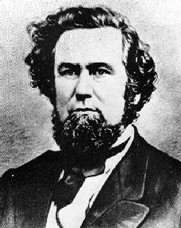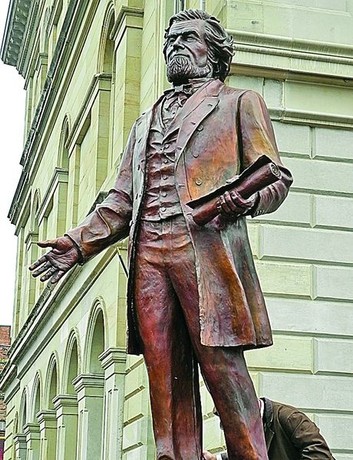Francis H. Pierpont Statue
Introduction
Text-to-speech Audio
Francis H. Pierpont was an American lawyer who was born in Morgantown, WV. Pierpont gained recognition during the Civil War as an active supporter of Abraham Lincoln and the Union. He adamantly opposed Virginia’s secession from the Union, and would lead the effort of some Virginia counties to secede from Virginia and create their own pro-Union state. As a result, Pierpont is often referred to as the “Father of West Virginia.”
Images
Francis H. Pierpont

Pierpont statue found at U.S. Capitol's National Statuary Hall Collection. Dedicated by the state of West Virginia in 1910.

Pierpont statue found at West Virginia Independence Hall in Wheeling. Unveiled on June 20th, 2015

Backstory and Context
Text-to-speech Audio
Pierpont was the third son of Francis Pierpont, being born at the family's plantation along the Cheat River on the Morgantown-Ices Ferry Road in Monongalia County (West) Virginia. Young Francis' middle name, "Harrison," was added later by the boy's father in honor of his former commanding officer, General William Henry Harrison. Pierpont, the original family name, was altered to Peirpoint in the land office at Richmond, VA in issuing patents for land deeded to his grandfather. The family was advised, by Virginia lawyers, that in order to hold their grandfather's land they must spell their last name as recorded in the patent. His father used the name Peirpoint throughout all of his life. Francis Harrison also utilized Peirpoint throughout most of his adult life including during his terms as the Civil War and Reconstruction Governor of Virginia. In 1880, when President Garfield appointed him Collector of Internal Revenue, Peirpont sent his name to the U.S. Senate as Francis H. Pierpont. Pierpont writes that "He consented to the change of his name because it was right.
Pierpont grew up in Fairmont, which is in Marion County, WV and graduated from Allegheny College. While studying to become a lawyer he was a teacher in Virginia. His first appointment as an attorney after passing the bar was for the B&O Railroad. He eventually became more involved with politics around 1840 as a supporter of the Whig party. He was a heavy supporter of Abraham Lincoln, when Virginia seceded from the Union and entered the Confederacy. Working in support of Lincoln’s administration, he focused on raising support for the Union, promoted “free schools”, and focused on extending constitutional rights to the freed men which would come about with the abolition of slavery from the Emancipation Proclamation.
Pierpont grew up in Fairmont, which is in Marion County, WV and graduated from Allegheny College. While studying to become a lawyer he was a teacher in Virginia. His first appointment as an attorney after passing the bar was for the B&O Railroad. He eventually became more involved with politics around 1840 as a supporter of the Whig party. He was a heavy supporter of Abraham Lincoln, when Virginia seceded from the Union and entered the Confederacy. Working in support of Lincoln’s administration, he focused on raising support for the Union, promoted “free schools”, and focused on extending constitutional rights to the freed men which would come about with the abolition of slavery from the Emancipation Proclamation.
Pierpont and other politicians from the thirty-two northwest Virginia counties would met at the Wheeling Convention, in which he became the provisional governor, to discuss a repeal of Virginia’s secession from the United States. The first meeting in May of 1861 would establish a portion of northwest Virginia as the Restored government of Virginia and draft a new Virginia Constitution. When the Second Wheeling Convention came to order, Pierpont was unanimously elected governor on June 20, 1861. He would eventually be reelected for a second term on May 28, 1963. During his second term, the Wheeling government submitted by popular vote for the creation of a new and separate state. Pierpont was one who fought hard during this time for a separation of North and South.
West Virginia would be the name of the new state and became part of the Union on June 20, 1863. With a new state created, Arthur Boreman would become the first governor. Pierpont became the governor of the Restored government of Virginia once again. He would eventually become the Governor of Virginia during the Reconstruction period after the Civil War. In 1868 was relieved by Henry H. Wells as governor and he returned back to his law practice in West Virginia.
Not long after his return to West Virginia he was elected to the House of Delegates as a Republican member in 1870 where he served one term. He would eventually retire from politics and public office after a stint as a collector for the Internal Revenue under President James Garfield. After retiring he would go to help create the West Virginia Historical Society. Francis Harrison Pierpont died at his daughter’s home in Pittsburgh, Pennsylvania on March 24, 1899. To show recognition of his importance to state history, West Virginia donated a statue of Pierpont to the U.S. Capitol’s National Statuary Hall Collection. Also on June 20, 2015, West Virginia Day, he received another statue unveiled in his recognition at Independence Hall in Wheeling, WV.
Sources
1. Barksdale, Kevin T. "Francis Harrison Pierpont (1814–1899)." Pierpont, Francis Harrison (1814–1899). Accessed October 19, 2016. http://www.encyclopediaVirginia.org/Pierpont_Francis_H_1814-1899.
2. "A GUIDE TO THE FRANCIS H. PIERPONT RESTORED GOVERNMENT EXECUTIVE PAPERS, 1861-1865." Library of Virginia. Accessed October 19, 2016. http://ead.lib.Virginia.edu/vivaxtf/view?docId=lva/vi00167.xml;query.
3. "Article Search (U.S. National Park Service)." National Parks Service. Accessed October 19, 2016. http://www.nps.gov/resources/person.htm?id=29.
